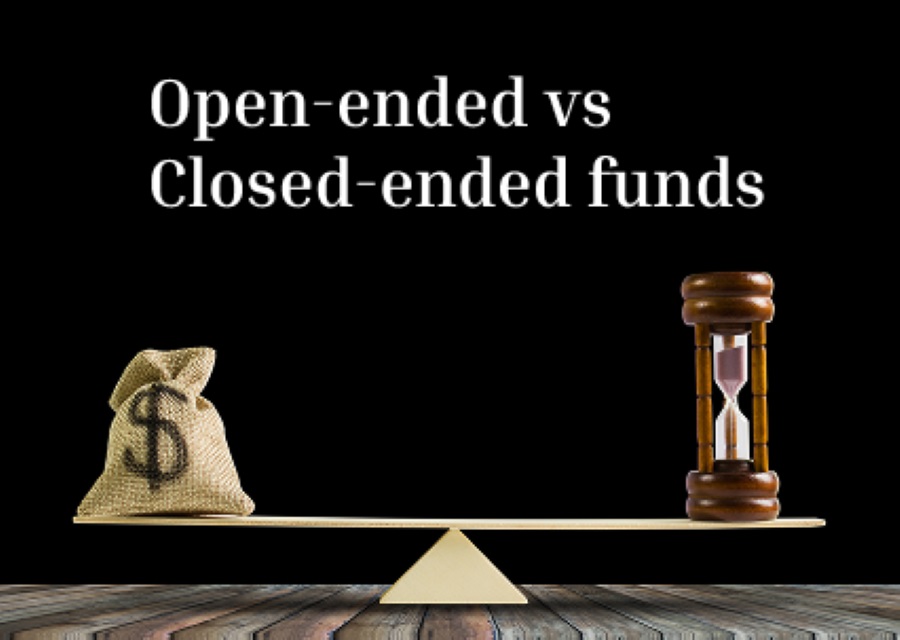Simplifying Life Insurance in India
Difference Between Open-ended vs Closed-ended Mutual Funds

Open-ended and closed-ended funds are two different kinds of mutual fund investment tools, each with distinct characteristics. The open-ended mutual fund allows purchasing or selling units at the NAV on any business day, making it more flexible and liquid.
In contrast, closed-ended funds have a fixed number of units, and investors can only buy or sell them on the stock exchange after the IPO or NFO. This article will help the investor decide based on the investment objectives, liquidity requirements, and risk profile. Read on to demystify the differences between them.

Table of Contents

What are Open-Ended Mutual Funds?
Open-end funds are collective investment schemes that permit investors to buy or redeem units directly from the fund at any time. These mutual funds allow investors to buy or sell units at any time based on the prevailing Net Asset Value (NAV). The AUM of these funds can sometimes differ from one another as unit holders keep buying and redeeming units.
The Asset Management Company (AMC) has managed the open-ended funds. There is flexibility in entry or exit without restricting lots or the maximum number of units available.
What are Closed-Ended Mutual Funds?
Close-ended funds are another type of investment scheme. In this, fixed numbers of shares are issued only through the New Fund Offer (NFO). The shares are then listed on a stock exchange and traded like stocks. Investors buy and sell closeable fund shares in the secondary market. However, the fund does not issue new shares and does not buy shares from the market.
The market price of close-ended fund shares can vary. Sometimes, it can trade at a premium or discount to the fund's Net Asset Value (NAV), depending on the market demand and supply. Close-ended funds are usually suitable for investors who can hold an investment for a given period and seek slightly higher returns.
Key Differences Between Open-Ended Funds and Closed-Ended Funds
Close-ended and open-ended mutual funds are the two types of mutual funds. Knowing the differences would help the investors make the right choice depending on the value they need. Here's a breakdown of the typical differences between the two:
Advantages of Open-End and Closed-End Mutual Funds
Open-end and closed-end mutual funds differ in terms of investment advantages. The key advantages of each are given below:
Disadvantages of Open-End and Closed-End Mutual Funds
A closed-ended and open-ended mutual fund has several disadvantages that all investors should consider. This helps you arrive at a wiser decision for your investments. So check the table below to know about the disadvantages of both the funds:
Which is Better: Open-Ended or Closed-Ended Mutual Funds?
Open-ended mutual funds can be the best option compared to open-ended and closed-ended mutual funds. However, this depends on your choice based on your resource potential and risk appetite.
- Open-Ended Funds: The size of open-ended funds is variable since investors can buy or sell units at any time at the prevailing NAV. Thus, they are ideal for long-term investors looking for steady growth, liquidity, and flexibility.
- Closed-Ended Funds: These funds are available only during an NFO. These funds have a fixed maturity period and a constant number of units listed on stock exchanges after the IPO. They suit investors with long-term investments.
- The right fund choice: One can opt for an open-ended fund for liquidity and flexibility, but closed-ended funds are preferable for a structured and long-term investment. Also, risk tolerance and the financial goal to minimise market risk.
Closed-ended and open-ended mutual funds are different products that have respective advantages. Both serve different requirements and are geared toward different classes of investors. What distinguishes them is based on various objectives in finance, risk tolerance, and favourite investments.
Disclaimer: The information provided on this website is for general informational purposes only and should not be construed as financial, investment, or legal advice. While we strive to provide accurate and up-to-date content, we do not guarantee the completeness, reliability, or suitability of the information for your specific needs.
We do not promote or endorse any financial product or service mentioned in these articles. Readers are advised to conduct their own research, consult with financial experts, and make informed decisions based on their unique financial circumstances. Any reliance you place on the information provided here is strictly at your own risk.
FAQs about Open-ended vs Closed-ended Funds
How do liquidity and redemption differ between open-ended and closed-ended mutual funds?
Can I purchase units of open-ended mutual funds at any time?
Do closed-ended funds offer the same flexibility when buying as open-ended funds?
Are closed-ended mutual funds subject to market price fluctuations?
Can I redeem my investment in a closed-ended fund before maturity?
Do open-ended funds have a fixed number of shares?
How do I determine the price of an open-ended mutual fund?
Are closed-ended funds more suitable for short-term investors?
Can I access my money quickly in an open-ended fund?
What happens if there is a large-scale redemption in an open-ended fund?
What is the difference between an open-ended fund and a closed-ended fund?
Which is better, an open-end fund or a closed-end fund?
It depends on your needs: open-ended funds offer liquidity, while closed-ended funds may offer the potential for higher returns but with less liquidity.
What are the main types of closed-end funds?
Is it possible to redeem closed-end funds after the New Fund Offer (NFO) period ends?
Why is it called a closed-end fund?
It's called a closed-end fund because it has a fixed number of shares that are not redeemable, and units can only be bought or sold on the stock exchange.
Is ELSS a closed-end fund?
Which is a more tax-efficient, open-ended fund or closed-ended fund?
Other Important Articles about Mutual Funds
Disclaimer
- This is an informative article provided on 'as is' basis for awareness purpose only and not intended as a professional advice. The content of the article is derived from various open sources across the Internet. Digit Life Insurance is not promoting or recommending any aspect in the article or its correctness. Please verify the information and your requirement before taking any decisions.
- All the figures reflected in the article are for illustrative purposes. The premium for Coverage that one buys depends on various factors including customer requirements, eligibility, age, demography, insurance provider, product, coverage amount, term and other factors
- Tax Benefits, if applicable depend on the Tax Regime opted by the individual and the applicable tax provision. Please consult your Tax consultant before making any decision.
Latest News
Read More
















